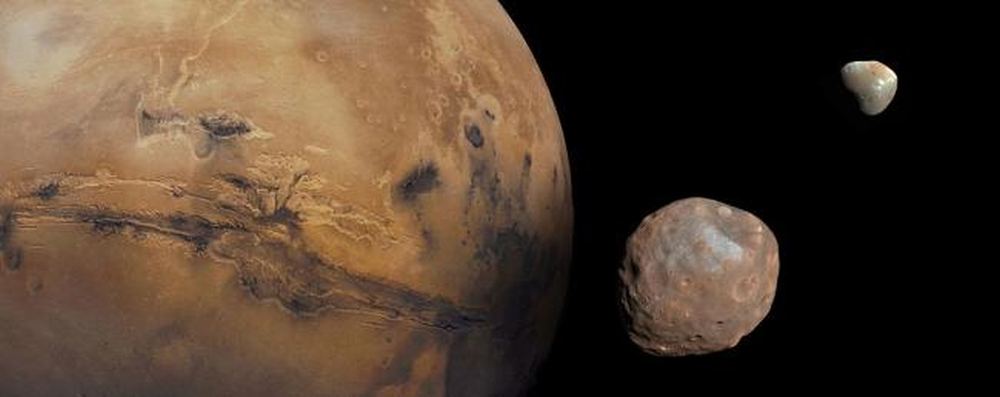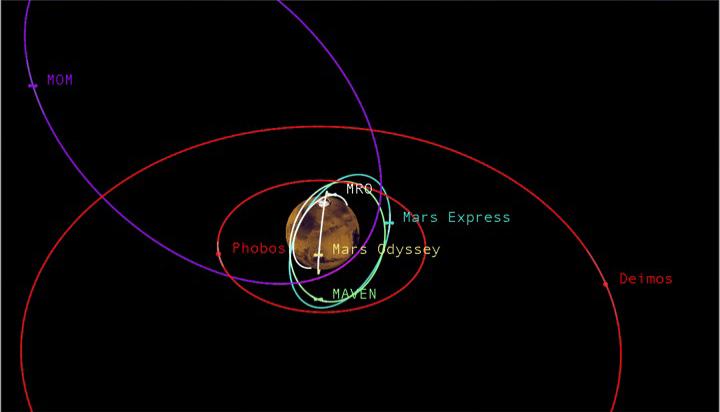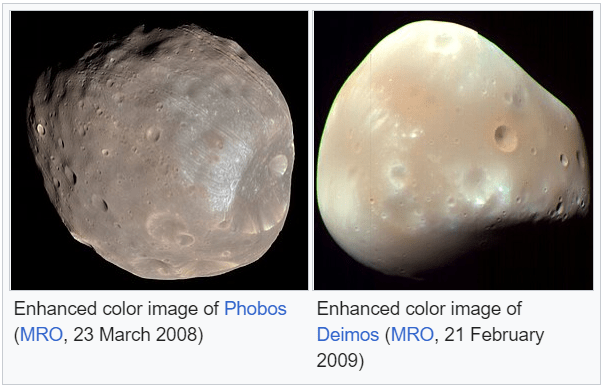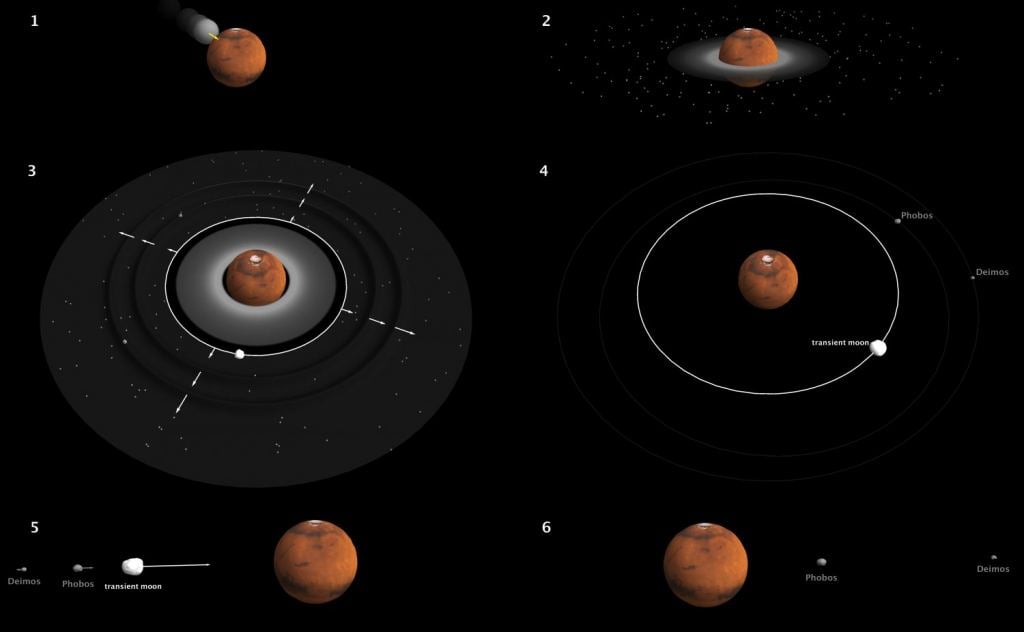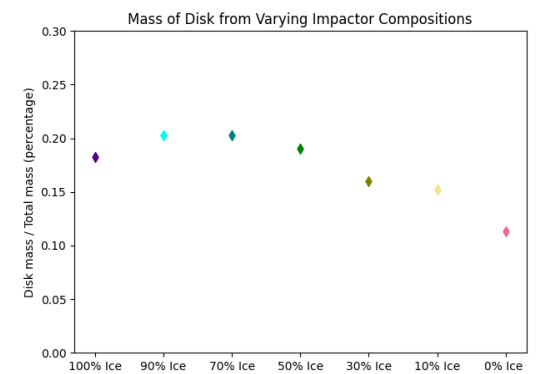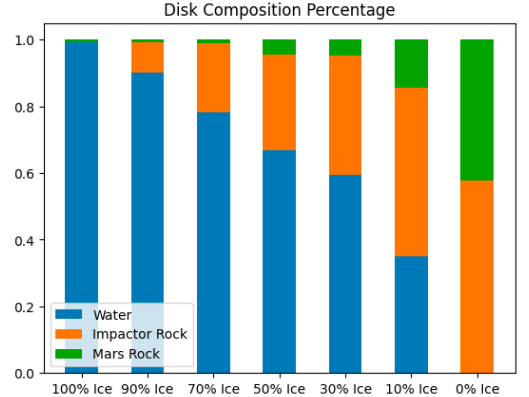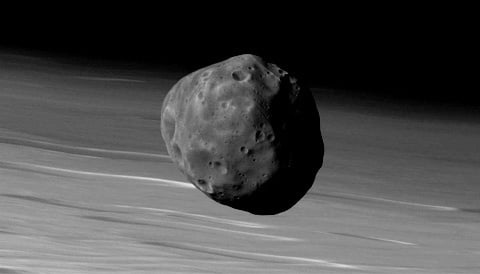The Martian moons Phobos and Deimos are oddballs. While other Solar System moons are round, Mars' moons are misshapen and lumpy like potatoes. They're more like asteroids or other small bodies than moons.
Because of their odd shapes and unusual compositions, scientists are still puzzling over their origins.
Two main hypotheses attempt to explain Phobos and Deimos. One says they're captured asteroids, and the other says they are debris from an ancient impactor that collided with Mars. Earth's moon was likely formed by an ancient collision when a planetesimal slammed into Earth, so there's precedent for the impact hypothesis. There's also precedent for the captured object scenario because scientists think some other Solar System moons, like Neptune's moon Triton, are captured objects.
Phobos and Deimos have lots in common with carbonaceous C-type asteroids. They're the most plentiful type of asteroid in the Solar System, making up about 75% of the asteroid population. The moons' compositions and albedos support the captured asteroid theory. But their orbits are circular and close to Mars' equator. Captured objects should have much more eccentric orbits.
The moons are less dense than silicate, the most abundant material in Mars' crust. That fact works against the impact theory. A powerful impact would've blasted material from Mars into space, forming a disk of material rotating around the planet. Phobos and Deimos would've formed from that material. If they result from an ancient planetesimal impact, they should contain more Martian silica.
Here's the problem in a nutshell. The captured asteroid theory can explain the moons' observed physical characteristics but not their orbits. The impact theory can explain their orbits but not their compositions.
In research presented at the 55th Lunar and Planetary Science Conference, three researchers proposed a different origin story for Phobos and Deimos. They suggest that an impactor is responsible for creating the moons, but the impactor was icy.
The research is titled "THE ICY ORIGINS OF THE MARTIAN MOONS." The first author is Courteney Monchinski from the Earth-Life Science Institute at the Tokyo Institute of Technology.
If a rocky impactor slammed into Mars, it would've created a massive debris disk around the planet. Previous researchers have examined the idea using simulations and found that an impact could've created the moons. But the disk created by the impact would've been far more massive than Phobos and Deimos combined. The simulations showed that there would've been a third, much more massive moon created within Phobos' orbit that would've fallen back down to Mars. But there's no strong evidence of something that massive striking Mars.
Other impact studies used basaltic impactors. But those showed that the temperature in the debris disk would've been so high it would've melted the disk material and destroyed ancient chondritic materials. Since the pair of moons appear to contain those materials, a basaltic impactor is ruled out.
According to the research presented at the conference, an icy impactor can explain Phobos and Deimos' origins. There are three reasons for that.
The extra disk mass created by a rocky impactor would not be present. Instead, much of the mass in the impactor would've been vapourized on impact and escaped the system rather than persisting in the disk and being taken up by the formation of moons. There would've been no large third moon and no need to explain how it fell back to Mars.
The second reason concerns the composition of the moons. With abundant water ice in the collision, the temperature in the debris disk would've been lower. That would've preserved the carbonaceous materials in Phobos and Deimos today. It also can help explain their density and possible porosity. An icy impactor could've also delivered water to Mars, and we know Mars was wetter in its past.
The third reason concerns Deimos' orbit. It's not synchronous with Mars, and an icy impactor can explain that. With more water ice in the disk, there would've been a viscous interaction between the disk's dust and vapour that extended the disk, allowing Deimos to occupy its orbit.
The researchers used Smoothed Particle Hydrodynamic (SPH) simulations to test the icy impactor idea. They simulated giant impactors with varying quantities of water ice and watched as disks formed around Mars and moons formed in the disk.
They first found that an impactor with any amount of water ice produced a more massive debris disk. It could be because an impactor containing water ice would be larger, though less massive, than one without any ice. That allowed more material to spray from the planet into the disk. It could also be because the water ice absorbs some of the impact energy when it vapourizes. That would cool the disk temperature, lowering the velocities of particles in the disk and making them less likely to escape.
Varying the ice content in the impactor also affected the makeup of the disk. Different amounts of ice lead to disks with different amounts of Martian rock and impactor rock in the disk.
The temperature in the disk is a critical part of this. Different amounts of water ice in the impactor change the disk temperature and what types of materials in the disk would melt. Impactors with more than 30% ice create disk temperatures too low to melt silicates. Perhaps more tellingly, impactors with more than 70% ice result in a disk temperature too low to alter or destroy chondritic material, which both Phobos and Deimos are expected to contain.
According to the researchers, an icy impactor can also explain other features. "The existence of water in the impact-generated disk also suggests that water may condense, accounting for the possible water-ice content of the moons," they write.
Ultimately, the researchers say an icy impactor with 70% to 90% water ice mantles can explain the pair of moons.
"The best case for reproducing the moons' proposed compositions are the 70% and 90% water-ice mantle impactor cases, as they allow for low disk temperatures and more chances for chondritic materials to survive," they explain.
Unfortunately, that may not be realistic. "In our current solar system, an object with around 70% or 90% water-ice content is not exactly realistic, as the object with the highest amount of water content in our current solar system, Ganymede, is only about 50% water," they write.
But could things have been different in the past? Samples from asteroid Ryugu suggest that its parent body could've been up to 90% water. That number is based on the types of minerals in Ryugu. But unfortunately, scientists don't now for sure. Ryugu's parent body could have contained as little as 20% water.
But it's at least plausible that early in the Solar System's life, an impactor with 70% water ice could have existed. If so, then the icy impactor scenario could be a robust theory to explain the origins of Phobos and Deimos.
"This impactor would have come from the outer solar system around the time of giant planet instability," the authors write. During that time, outer Solar System bodies were perturbed and sent flying into the inner Solar System. But in this case, the impact's timing needs to be constrained by Phobos' and Deimos' formation ages.
Scientists need more evidence to deepen their understanding of Mars and its moons. Japan's Martian Moons eXploration (MMX) mission will provide that. MMX's mission is to return a sample of Phobos to Earth. The goal is to determine if it is a captured asteroid or the result of an impact.
Unfortunately, JAXA just delayed MMX's launch. It was scheduled to launch in September 2024 but has been delayed until 2026. That means we won't get samples until 2031 instead of 2029.
JAXA has completed successful sample return missions, so they have the expertise to bring a piece of Phobos back to Earth. If scientists can determine how Phobos and Deimos formed, it'll be part of a much larger, detailed picture of how the Solar System formed.
It'll be worth it if we have to wait a couple extra years.
 Universe Today
Universe Today
